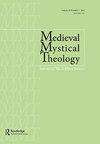Blind as a Bat: [Un]seeing the Visio Dei in the Granum Sinapis Diagrams
IF 0.3
0 RELIGION
引用次数: 0
Abstract
ABSTRACT The Granum Sinapis – the ‘Mustard Seed’ – an early fourteenth century German poem, is a concise expression of the mystical and paradoxical precepts of Meister Eckhart. To find the way into the nothingness of God’s mystery, one must pursue the path into the desert– a path without a route leading into a space with no boundaries. The composition was given its title by a Latin scholar whose scholastic commentary was transmitted along with the poem. Appended to the commentary are two crude diagrams, one, an empty circle, the other a set of concentric circles, that in their simplicity both mirror the poem as well as provide a final, eloquent gloss on the interaction between the apophatic theologies of Dionysius the Areopagite and Meister Eckhart. Like the vision of the bat looking into the sun, so does human understanding fail when contemplating God. Yet it is precisely through the medium of blindness that man comes closest to union with the divine.盲人如蝙蝠:在Granum Sinapis图中看到Visio Dei
摘要十四世纪早期的一首德国诗歌《芥子》,是梅斯特·埃克哈特神秘而矛盾的训词的简明表达。要想找到通往上帝神秘的虚无之路,就必须追寻通往沙漠的道路——一条没有通往无边界空间的道路。这首诗是由一位拉丁学者命名的,他的学术评论与这首诗一起传播。评论中附有两个粗略的图表,一个是空圆圈,另一个是一组同心圆,它们的简洁既反映了这首诗,也为阿雷奥派狄奥尼修斯和梅斯特·埃克哈特的阿波派神学家之间的互动提供了最后的、雄辩的光彩。就像蝙蝠凝视太阳的景象一样,人类在思考上帝时也会失败。然而,正是通过失明的媒介,人类才最接近与神性的结合。
本文章由计算机程序翻译,如有差异,请以英文原文为准。
求助全文
约1分钟内获得全文
求助全文

 求助内容:
求助内容: 应助结果提醒方式:
应助结果提醒方式:


